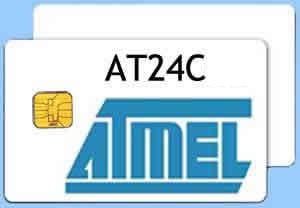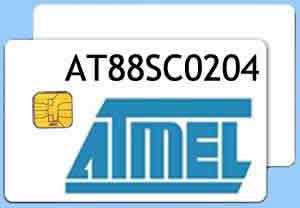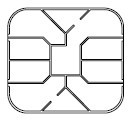AT88SC1608,
Features
• One 128 x 8 (1K bit) Configuration Zone
• Eight 256 x 8 (16K bits) User Zones
• Low Voltage Operation: 2.7V to 5.5V
• Two-wire Serial Interface
• 16-byte Page Write Mode
• Self-timed Write Cycle (10 ms max)
• Answer-to-Reset Register
• High Security Memory Including Anti-wiretapping
– 64-bit Authentication Protocol (under exclusive patent license from ELVA)
– Authentication Attempts Counter
– Eight Sets of Two 24-bit Passwords
– Specific Passwords for Read and Write
– Sixteen Password Attempts Counters
– Selectable Access Rights by Zone
• ISO Compliant Packaging
• High Reliability
– Endurance: 100,000 Cycles
– Data Retention: 100 Years
– ESD Protection: 4,000V (min)
• Low-power CMOS
The AT88SC1608 provides 17,408 bits of serial EEPROM memory organized as one configuration zone of 128 bytes and eight user zones of 256 bytes each. This device is optimized as a “secure memory” for the smart card market, secure identification for electronic data transfer, or components in a system, without the requirement of an internal microprocessor.
The embedded authentication protocol allows the memory and the host to authenticate each other. When this device is used with a host which incorporates a microcontroller (e.g., AT89C51, AT89C2051, AT90S1200), the system provides an “anti-wiretapping” configuration. The device and the host exchange “challenges” issued from a random generator and verify their values through a specific cryptographic function included in each part. When both agree on the same result, the access to the memory is permitted.
Depending on the device configuration, the host might carry out the authentication protocol and/or present different passwords for each operation, read or write. Each user zone may be configured for free access for read and write or for password-restricted access. To insure security between the different user zones (multiapplication card), each zone can use a different set of passwords. A specific AAC for each password and for the authentication provides protection against “systematic attacks.” When the memory is unlocked, the two-wire serial protocol is effective, using SDA and SCL. The memory includes a specific register providing a 32-bit data stream conforming to the ISO 7816-10 synchronous answer-to-reset.
Supply Voltage (VCC)
The VCC input is a 2.7V-to-5.5V positive voltage, supplied by the host.
Serial Clock (SCL)
The SCL input is used to positive edge clock data into the device and negative edge clock data out of the device.
Serial Data (SDA)
The SDA pin is bidirectional for serial data transfer. This pin is open-drain driven and may be wire-ORed with any number of other open drain or open collector devices. An external pull-up resistor should be connected between SDA and VCC. The value of this resistor and the system capacitance loading the SDA bus will determine the rise time of SDA. This rise time will determine the maximum frequency during read operations. Low value pull-up resistors will allow higher frequency operations while drawing higher average power supply current.
Reset (RST)
When the RST input is pulsed high, the device will output the data programmed into the 32-bit answer-to-reset register. All password and authentication access will be reset. Following a reset, device authentication and password verification sequences must be presented to re-establish user access.
Memory Mapping:The first 16K bits of the memory are divided into eight user zones of 256 bytes each.
FAB, CMA, and PER are nonvolatile fuses blown at the end of each card life step. Once blown, these EEPROM fuses can not be reset.
• The FAB fuse is blown by Atmel prior to shipping wafers to the card manufacturer.
• The CMA fuse is blown by the card manufacturer prior to shipping cards to the issuer.
• The PER fuse is blown by the issuer prior to shipping cards to the end user.
The fuses are read and written in the configuration zone using the address $80.
Ordering Information
| Ordering Code | Package | Voltage Range | Temperature Range |
| AT88SC1608-09ET-00 | M2 – E Module | 2.7V–5.5V | Commerical (0°C–70°C) |
| AT88SC1608-09PT-00 | M2 – P Module | 2.7V–5.5V | Commerical (0°C–70°C) |
| AT88SC1608-10PU-00 | 8P3 | 2.7V–5.5V | Industrial (− 40°C–85°C) |
| AT88SC1608-10SU-00 | 8S1 | 2.7V–5.5V | Industrial (− 40°C–85°C) |
| AT88SC1608-10WU-00 | 7 mil Wafer | 2.7V–5.5V | Industrial (− 40°C–85°C) |
| Package Type | Description |
| M2 – J Module : ISO or TWI | M2 ISO 7816 Smart Card Module |
| M2 – P Module : ISO or TWI | M2 ISO 7816 Smart Card Module with Atmel® Logo |
| 8P3 | 8-lead, 0.300” Wide, Plastic Dual Inline Package (PDIP) |
| 8S1 | 8-lead, 0.150” Wide, Plastic Gull Wing Small Outline Package (JEDEC SOIC) |
Smart Card Modules
Ordering Code: 09ET-00
Module Size: M2
Dimension*: 12.6 x 11.4 [mm]
Thickness: 0.58 [mm] max
Pitch: 14.25 [mm]
Glob Top: Round: ∅ 8.0 [mm] max
Ordering Code: 09PT-00
Module Size: M2
Dimension*: 12.6 x 11.4 [mm]
Glob Top: Square: 8.8 x 8.8 [mm]
Thickness: 0.58 [mm]
Pitch: 14.25 [mm]
*Note: The module dimensions listed refer to the dimensions of the exposed metal contact area. The actual dimensions of the module after excise or punching from the carrier tape are generally 0.4 mm greater in both directions (i.e., a punched M2 module will yield 13.0 x 11.8 mm).









Reviews
There are no reviews yet.